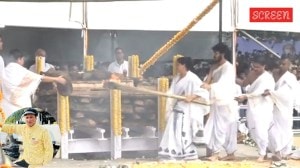‘No RDX in Mumbai blast’
A day after the rush-hour blast rocked Ghatkopar, investigators began to piece together a terror jigsaw that could have claimed scores of li...

A day after the rush-hour blast rocked Ghatkopar, investigators began to piece together a terror jigsaw that could have claimed scores of lives.
Police are probing the involvement of an Islamic fundamentalist outfit and have reasons to believe that the members met at Ghatkopar before planting the bombs in the two buses.
According to police sources, both buses plied in Ghatkopar. The BEST bus on route 416 used to ply between Amrut Nagar and Ghatkopar railway station, while the one on route 336 crossed Ghatkopar before coming to SEEPZ.
Also, the 14 gelatin sticks used to trigger the blast at Ghatkopar were similar to those found in Andheri. Police sources say the suspects could have got off the moving bus, about 30 meters from the last stop, before switching on the detonator.
Deputy Chief Minister Chhagan Bhujbal has ruled out the use of RDX in the blast even as he announced the formation of a quick response team to tackle subversive activities. Bhujbal told reporters that the team of National Security Guards, which arrived from Delhi this morning, suspects that the material used was a crude explosive.
He held a marathon meeting with Additional Chief Secretary Asoke Basak, Police Commissioner M.N. Singh, Railway Police Commissioner Rakesh Maria and senior officials of the NSG. ‘‘We have set up a quick response team comprising 56 highly trained persons to tackle subversive activities,’’ Bhujbal said.
‘‘The material used in Ghatkopar blast and explosives found in Andheri appear to be similar and the work of the same group of people,’’ he said.
While Bhujbal said it would be ‘‘improper’’ to link the 10th anniversary of Babri Masjid demolition with yesterday’s incident, the police commissioner said the link cannot be ruled out. The samples of explosives have been sent to the forensic lab at Kalina for tests.
The blast has sparked a scare in the city. An unclaimed bag sparked tension in a multi-storeyed complex near the United States Information Service building and Bombay Hospital, which is a high security zone.
Photos



- 01
- 02
- 03
- 04
- 05




























